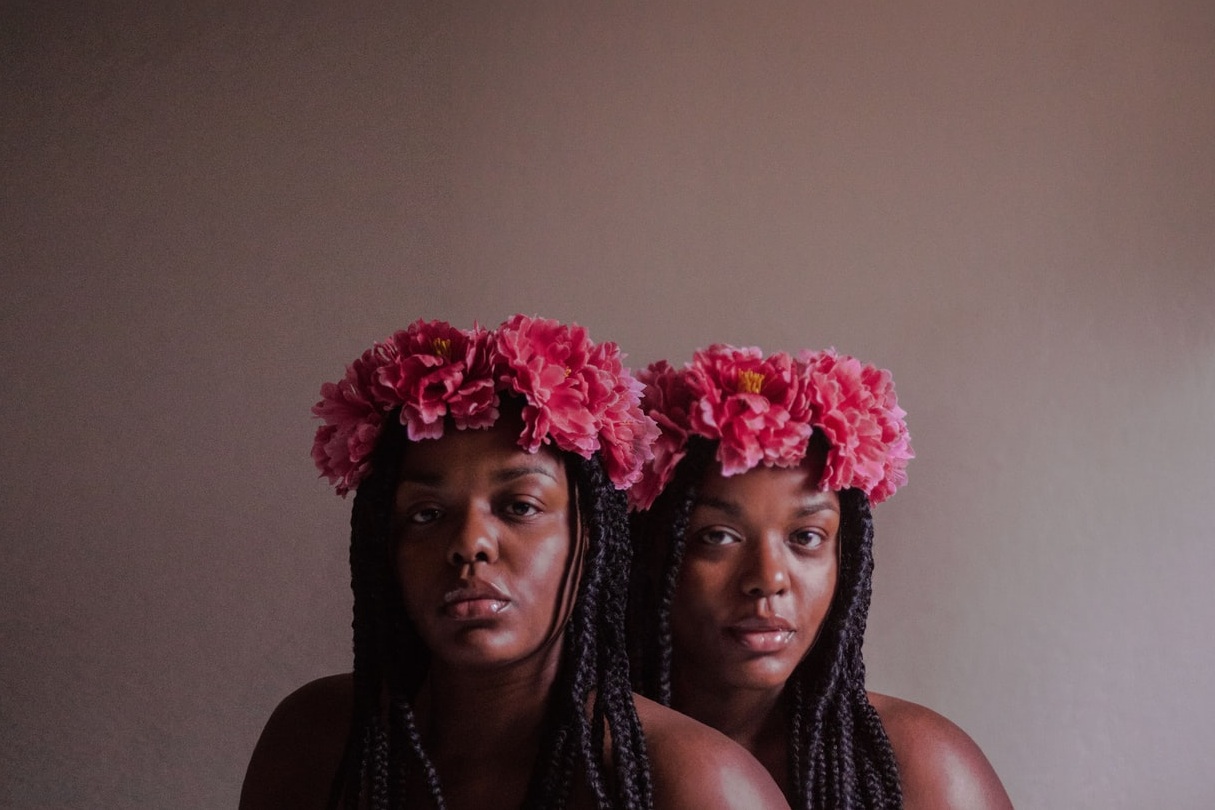An Intimate Question
A Gemic Whitepaper Rihanna dropped a bomb on the lingerie industry. In September, the New York runway show for the pop icon’s Savage x Fenty intimates line showed just how dramatically out of step the industry is with contemporary culture and how desperately it clings to residual models of femininity and sexuality.
Transforming the Brooklyn Navy Yard into a sensuous, sweaty tropical garden of Eden, the set, music and choreography of the show transported attendees into a gyno-cratic wonderland. Above and beyond what any brand in the industry has done with a show, including Victoria Secret with its annual extravaganza, Rihanna clearly presented more than just lingerie designs. She unveiled something very new to the lingerie business – a manifesto, a POV, an epistemology, a way of seeing and being in the world, a challenge.
It happened first through the models. Ostensibly led on the runway by Slick Woods, who later revealed she was in labor during the show, and Jazzelle Zanaughtti a.k.a. ‘uglyworldwide’ what the Irish Examiner called Rihanna’s “masterclass in diversity” was hailed for the inclusion of plus size as well as pregnant models. The show’s overall effect was clear: Savage x Fenty is the new major player in lingerie and Rihanna’s spin on femininity, power, sexuality and contemporary culture is so much more relevant to today’s young female consumer that every brand from Victoria’s Secret to Agent Provocateur and La Perla is officially on watch.
Old school brands will be slow to respond because, for all its supposed sexiness, lingerie is in fact a very conservative industry. Like other goods that index privacy or intimacy like feminine hygiene products, it has, at best, been slow on innovation and resistant to change. At worst, it has acted as one of many flagbearers for prescriptive, patriarchal female roles.
Young women today are aware of those roles and how they have so deeply insinuated themselves into mainstream, patriarchal culture. They are also familiar with how its themes have played into the satiny smoothness of the leading lingerie brands. And the overwhelming consensus is that most young women are unwilling to play along with those roles and themes – let alone pay the prices. This is a challenge. In an age where femininity itself is being weaponized, whereby even being in possession of a female or female-identifying body is to exist under threat, young women look at a product category such as lingerie and ask themselves, “How does this speak to me” and “How does this reflect my values?”.
Ultimately, brands need to respond to today’s young female consumer (and by ‘young’ we should really look to the parental Gen Xers as the seed of many of these shifts) with a fruitful, safe and connected space that can engage directly and intelligently with her and her needs. This is a challenge for virtually all lingerie brands, as many of them still spend most of their marketing and communication efforts attempting to titillate consumers with historic, male-facing fantasies of the virgin and the whore. And so we enter the key moment, that time when “old-world-sexy” (think Fredericks of Hollywood, ‘American Pie’, Sports Illustrated) has already been dismantled and is gradually being replaced by the values and desires of a new generation: women learning to become their own icons and idols. To help lingerie brands understand this, we have identified three key shifts in cultural values that brands should be responding to:
1/ The evolution of bodily perspectives
Intersectionality explores the complexity of how multiple identities exist simultaneously. It refuses to privilege a single, dominant narrative; one that is white, hetero, able-bodied, slim. It is founded instead upon an inclusive and interwoven femininity. It refutes competition for the male gaze. It seeks to explore, rather than siphon off, the complexity of female identities.
It is not limited to representation. Some brands and campaigns – like Victoria Secret’s Perfect Body – fulfil surface-level engagements with contemporary femininity but fail to integrate intersectionality. Others, like Aerie, boast major credentials by being the first mass market lingerie brand to remove airbrushing from campaigns and extend their representation of women by featuring models in wheelchairs, with colostomy bags and other disabilities. For Aerie, the ideal body becomes a site where multiple identities come together and demonstrate that there is not one correct way to be a woman. Other brands look to integrate intersectional values into their supply chain (lingerie is overwhelmingly – unsafely and painstakingly – produced by women of color), such as Hesperios, Hara and BehindBars that provide textile-based training for incarcerated women. Now that is intersectionality.
By appealing to a greater number of women, rather than side-lining certain bodies in favor of others or representing women as two-dimensional planes upon which to project male fantasies, brands that acknowledge and support intersectionality have and will continue to reach more women and maintain far deeper connections with female consumers. Just the plus-size market alone should prove this with its 17% increase between 2013 to 2016.
Here, the key shift is from the body as a singular, idealized, static object to the body as an open, accumulative, changing story. The embracing of imperfection leads to greater storytelling, a more robust narrative arc: stretch-marks, moles, sagging, scars, tattoos all show a woman’s collection of experiences. To be airbrushed is to symbolise naïveté and unknowing. As we culturally and aesthetically move away from the sanitising wave of mid-2010s Minimalism – we open ourselves up to a richer way of being and conversing.
Even Luxury itself is less about attaining an externalised ideal, and closer towards enabling internal growth and expression. Old World luxury privileged the ornamental – objects of excess, opulence and status – but today, as our cultural values have shifted towards optimisation, innovation and purpose, the object of New Luxury is an ‘enabler’. This is particularly pertinent in lingerie, for a generation of young women who came of age in a recession, with a distrust of institutions, and an eye on their pockets. To them, living up to a frivolous ‘fantasy’ is no longer their idea of a luxury spend.
Take, for example, the monumental rise of the triangle bra in recent years (sell outs in 2017 rocketed by 120%), usurping its predecessor: the push-up or plunge bra, sales of which have fallen by 50%. Instead of scaffolding and contorting the female body, the triangle bra and other soft-cup bras simultaneously merge performance and comfort (much like the parallel trend in athleisure). So, too, they also hold a strong symbolic power that lingerie does not speak for the woman (and nor do her bodily ‘assets’), but rather becomes a tool to enable a greater, more free expression of the self. The triangle bra has formulated its own identity and sex-appeal, as crafted by women.
2/ Emergent Sexuality: From Objectification to New Subjectivity
We are living in a post-Roe v. Wade, post-AIDS, post-Lawrence v. Texas culture. The pop side of that culture has taken to depicting sexuality in frank and authentic ways – from Lady Bird to Call Me By Your Name – one of which is that pleasure is no longer owned solely by thin, white, able, hetero bodies. The once seedy sex toy industry is now opening up directly to women alongside sexual health and wellness products rather than through hushed innuendos and raincoat purchases for “body massagers”. Brands such as Maude (“modern sex essentials for all”) and Chakrubs – the latter of which produces rose quartz and amethyst devices – are visually reshaping the industry that was once dominated by hot pink, (dangerous) synthetics and marabou. Even Pornhub is diversifying to become a ‘lifestyle’ brand with ‘drops’ and collaborations in fashion, music, tech and health. In the age of #MeToo, the foundational dialogue over sex and sexuality has come to the fore – recognising that historic shame and embarrassment over women’s bodies is what has ushered in claims to a ‘grey area’ – openness and frankness is the new currency. Brands must address their consumer with honesty, trust and advocacy to promote self-assertion, particularly when dealing with intimate products (that typically go unregulated).
Instead of positioning the female body as the target of the male gaze, the new sex-positive age values truth, frankness, openness and humor. Take, for example, the prevalence of the ‘female gaze’ in sexual-wellness culture – the work of Arvida Bystrom and Petra Collins heavily inspired the campaign materials for Thinx (a free-bleeding underwear company) and Billie (the first, female-forward, DTC shaving company to show body hair). The female-gaze is intimate and honest, depicting the female body as agentic, non-objectified – it often reclaims the sensuality and primality of pink and neutrals, emboldening them with a new power. In this new age of positivity and wellness, all consensual sex is good sex. And within this new way of being with each other, femininity is increasingly moving away from gender essentialism towards gender performativity. Here, femininity is about what you do, not who you ‘are’. Essentially, behaviour creates gender, so a claim to being a woman does not rest with biology but upon ascribing to certain practices. As such, lingerie is not a material product but a process.
This opens very wide spaces for the lingerie industry to play with historic, outdated codes and craft new ones not founded on a sexuality shaped solely by (male) fantasy and ‘the unattainable’ but by the authentic, the real, the confident and the self-assured, written by women.
3/ New Luxury, New Consumer Preferences, New Models
Women’s purchasing power is significant. Particularly in old world gifting spaces such as lingerie or jewelry, women are often making purchases themselves for themselves.
Here we are witnessing the crux of a radical shift, from the category of Woman being a product that could be consumed, to Woman being recognised as a consumer in her own right. Formerly ‘womanhood’ was a product for consumption by women – as they purchased objects and accessories in order to live up to pre-set codes – and by men. Today, we see this refusal to ascribe to pre-set codes of womanhood in the rise of unisex lingerie, and clothing in the mainstream. Serena Rees, former co-founder of Agent Provocateur, made the switch to unisex lingerie with her new label ‘Les Boys, Les Girls’: a high-end, streetwear-infused brand that features high-rise briefs, silk boxer shorts and Le Marais-style luxe-sweats. Here, lingerie can still be a desirable, luxury, even frivolous purchase, but it is no longer imbued with the transactional expectations of gifting and wanting, nor limited to one gender expression. The woman’s purchase instead becomes a symbol of pride and play.
This is a current point of discussion: Is the luxury industry outdated and, if we can agree that some houses are truly in better shape than others, what is, could be or will be the New Luxury? Beyond creating a spinoff of Burberry’s digital strategy from past years or launching an online art gallery, how might luxury brands communicate, engage with and perhaps do something (serve?) more for female consumers? And perhaps most importantly of all, How might luxury brands incorporate, leverage or harness contemporary cultural values without losing the special glow, prestige and exclusivity of being a luxury brand?
Luxury or not, the lingerie business is experiencing what can variously be described as a disruption, a transformation (that is still very much in the making) or a radical break with the social values of the past. For those brands that have not embraced this ongoing change and are not somehow already engaged in promoting the opening of new spaces of performed identity, the danger is clear: irrelevance or, at the very least, repugnance. We saw the repugnance clearly in the Open Letter to Victoria’s Secret from Heidi Zak, the founder of bra company Third Love. Tearing through social media in November after the Victoria’s Secret CMO made what Zak described as “shocking, derogatory statements” about plus sized women and transsexual models in Vogue, it drove home two stark realities for the brand: that women live in reality, not in a fantasy, and that in the world of Victoria’s Secret the customer does not exist.
This is not just a challenge for Victoria’s Secret, whose popularity and market share makes it the easiest (and most obvious) target, but it’s a challenge for every lingerie brand not living the new value paradigm.
The Bad News
There is no easy way – and perhaps no way at all – to market yourself out of this decline. Young women can sense whether you are a real thing or not. And chances are that, right now, as a relatively established, traditional and conservative brand, you aren’t a real thing for Millennials and Gen Z. So instead of marketing mumbo jumbo, you need to…
Accept It
Know that this is not a trend but a permanent end shift. Frilly underpants might not go away, but how we, as a culture of progressives – not populists – view, accept and love the many people who want to wear those underpants has forever changed and been set on an entirely new social, cultural and historical trajectory.
Understand It
You don’t need to be a scholar to understand big topics like intersectionality. You need to be open and sort of smart, that’s all. Those of us who observe and participate in popular culture have seen this shift coming for years on TV, in film, in literature and beyond. The signs are there. All you have to do is understand when, how and by whom they were posted.
Understand It Globally
Consider how new modes of femininity translate across cultures. This is a site of anthropological investigation, especially in places where the trajectory of Western feminism does not fit like in China where women have been more active political and social players, or in the Middle East where lingerie has an interesting role to play in defining self-hood and personal agency.
Start Changing
Perhaps the most valuable thing as the established, traditional, conservative brand that you can do is ask yourself if a C-Suite full of 40+ heterosexual, white men is the best idea for the growth of your business. This is not a call to purge – great leaders are great leaders regardless – but a call to bring in new, more diverse and more different talent.
Buy and Scale
Learn from the beauty industry and acquire an up-and-coming lingerie brand that either is representative of or makes sense within this newly emerged cultural space. Then, after following a careful, smart and sensitive M&A process, scale it to be your next big thing.
Be Bold
Nothing will say you’re the same old established, traditional, conservative brand than tentative steps forward. If you want to do it, do it. Doing it garners respect and even loyalty.
Lingerie brands should not simply ask, How can we reflect contemporary femininity? or How can we present new role models and/or aspirational forms? Instead, in recognizing the history of their industry as one which has arguably treated the women wearing their products as passive objects of consumption designed for the pleasure of the male gaze, they should be considering how they can play a new and meaningful role in a woman’s life, either actively or symbolically. Simply put but far from simple, that is the question.








